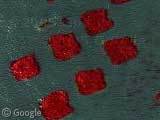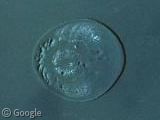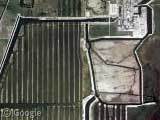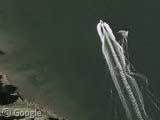Red Water Weirdness
Tuesday, 5th July 2005 by Alex Turnbull
Update: It seems that this is an artificial kelp reef. However, we're much more interested in the underwater ketchup farming! (Thanks guys 🙂 )
Does anyone know what on earth this weird red stuff is off the coast of Anaheim, California?
Thanks to a few people, but Steven Lagavulin was first there 🙂





Odd patches of red seaweed or algae perhaps?
http://www.surfrider.org/a-z/red_tide.asp red tide or red algae bloom it mentions southern cali. that was an obvious one. 😉
New underwater ketchup farms most likely.
Red tide was my first thought, too. It’s something we have on occasion here on the Texas Gulf coast. But having seen the photos, I’m baffled. Those patches appear almost regular in appearance, squarish in shape, and some of them appear to be evenly spaced. On second thought, I’m also going to say “underwater ketchup farms” too.
I live maybe 5 minutes walking distance from there. My best guess is algae. The pile of rocks near it is called Seal Rock. During the night you can hear the seals barking from quite a distance.
But how could algae grow in…in…squares?
Yeah… definitely underwater ketchup farms.
I’ll go with kelp.
The redness varies with angle, and some of the nearby stuff looks like kelp to me. Kelp in California is harvested with really big ships which are driven through the kelp and harvest in a straight line just like a farm harvester. Maybe they leave some patches unharvested for some reason?
There are seven groups of 8 squares a piece…
there’s no way that can just be random….
there’s no way that can just be random….
Listen to the people, man. Underwater ketchup farms.
How about….Cristo’s new installation!
Leftover fingerpaint on the camera lens…
Its most def red tides.
Artificial reefs.
http://www.sce.com/SC3/PowerandEnvironment/PowerGeneration/MarineMitigation/KelpReefProject.htm
I guess he is right…
But one question remains unsolved… Where are the underwater ketchup farms? Where does the ketchup come from? 😉
Its war of the worlds all over again. They wont use me as fertilizer
Uh, Anaheim is a landlocked city about 30 miles to the north.
The kelp is off the coast of San Clemente.
There seem to be more ketchup farms in lake Ontario!
View Placemark
This looks more like some sort of picture ghosting. You can see that the red “shadow’s” shape and textures are an exact replica of the shore.
Man-Made Reef May Make Amends for San Onofre’s Environmental Damage
June 29, 2005 — By Paul Sisson, North County Times
SAN CLEMENTE, Calif. — Like an underwater field of dreams, they built it and the kelp came.
A team of Southern California research biologists last week released their draft report on the success of an experimental test reef built to make amends for the death of giant kelp forests caused by the San Onofre Nuclear Generating Station.
Kelp is the undersea habitat that provides shelter for a rainbow of aquatic plant and animal life.
The report, which will be presented to the public Wednesday, concludes that 56 underwater test reefs built by plant owner Southern California Edison readily served as the launch pad for kelp forests. In turn, those kelp forests attracted tons of fish and other bottom-dwelling invertebrates, such as the spiny brittle stars that sometimes can be found in North County tide pools.
Dan Reed, a research biologist at the University of California Santa Barbara, said Monday that five years of intensely monitoring the experimental reefs built off the coast of San Clemente just a few miles north of San Onofre’s twin reactor domes, reassured him that kelp could be restored.
“I think there’s a lot of reason to be hopeful that the detrimental effects that the power plant has on the kelp bed at San Onofre can be offset by building the artificial reef off of San Clemente,” Reed said.
Wednesday’s public workshop will be held from 12:30 to 5 p.m. at the San Clemente Community Center, 100 N. Calle Seville, San Clemente. The workshop, which will allow people to ask questions of experts in attendance, is designed simply to present information on the results of a five-year artificial reef monitoring study. It is not a public hearing and no regulatory decisions will be made.
The artificial reef is designed to compensate for the side effects of San Onofre’s unquenchable thirst for salt water.
According to Edison, the plant sucks nearly 2.5 billion gallons of salt water from the Pacific Ocean every day. The water is used to cool the plant’s innards before being pumped back into the ocean. However, when that water is released back into the briny blue, it kicks up a murky plume of sand and other murky material. Reed said studies performed in the 1980s showed that cloudy water means less sunlight reaches kelp. Without enough sunlight, young kelp does not grow.
“It’s really affecting the birth rates of new plants rather than killing the mature plants,” Reed explained.
In 1991, the California Coastal Commission ordered Edison to build an artificial reef to pay Mother Nature back for the one that its nuclear plant’s liquid exhale took away.
After nearly a decade of wrangling, the Coastal Commission decided that Edison should build 150 acres of artificial reefs to replace what was lost at San Onofre. However, before building the large reef, Edison decided to build several small experimental reefs first. Scientists wanted to explore what kind of materials the artificial reef would best be made from.
So, in 1999, Edison sank 56 piles of boulders and concrete. The piles had different densities and different mixtures of concrete and stone. Some covered more of the sea floor than others. After the piles were in place, a team of divers routinely visited them for five years, recording changes as they happened.
“They pretty much used up all the graduate student divers in all of Southern California for the last five years monitoring that project,” said David Kay, manager of Edison’s environmental mitigation program.
According to the report, divers watched kelp take hold quickly in most of the piles after spores drifted over from the adjacent San Mateo kelp bed. The report notes that all artificial reefs exceeded their performance standards, maintaining at least four mature kelp plants since 2001. Likewise, divers found that fish and invertebrates also moved into the new kelp stands at a rate that paralleled natural kelp forests like San Mateo to the south.
While artificial reefs have become somewhat common in the world’s oceans, Kay and Reed both said it is rare to do a five-year scientific study before building one.
Reed noted that there were few large ocean storms or other disruptive events from 2000 to 2005, so the survey does not necessarily say how well the artificial reefs will hold up to the roughest stuff that nature can throw at the man-made reefs.
“Five years is a decent amount of time, but it’s not enough to capture the entire picture of what really happens out there,” Reed said.
The report also notes that divers began spotting “high densities” of an ocean sea fan plant called muricea on all of the reefs in 2002 and 2003. Reed said that if the sea fans continue to propagate, they could eventually crowd out the kelp.
“It still remains to be seen whether that will be much of a problem,” he said.
The report concludes that it may be necessary for Edison to hire divers to periodically kill the sea fans if they get too dense.
Kay, Edison’s project manager, said a healthy kelp bed needs a good whack from the ocean every now and then. When rough weather and or marine animals tear through the kelp forest, he said they often also remove some build-up of animals and plants that can crowd out kelp.
“The only way to assure that kelp continues to get a foothold is to scrape everything off periodically and nature does that with natural kelp beds,” Kay said.
It will be the California Coastal Commission that decides exactly how much rock should be placed on the sea floor to create the artificial reefs. Kay said Edison will probably ask for a more sparse load of rock initially to ensure that the reef does not become impervious to natural forces that help renew the kelp forest.
“It’s easier to add material than take it away,” he said.
However, Reed said the total amount of reef rock to be used for the 150-acre reef has not yet been discussed between the contract scientists from UC Santa Barbara and Edison’s own scientists.
“I guess the discussion needs to become, what’s a reasonable starting point,” Reed said.
To see more of the North County Times, or to subscribe to the newspaper, go to http://www.nctimes.com.
Source: Knight Ridder/Tribune Business News
oh!
Ketchup farms is the only solution